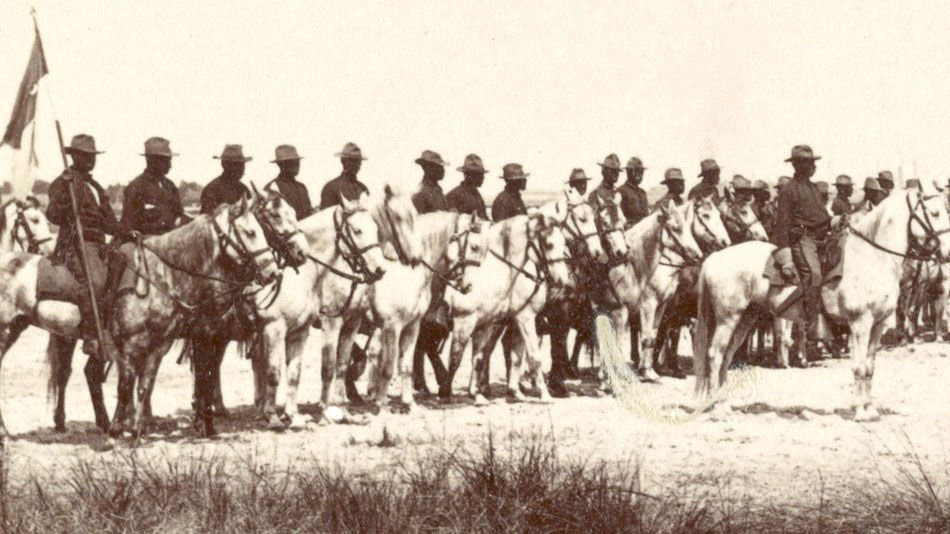
In 1866, right after the close of the Civil War, Congress created six (later consolidated to four) regiments of African-American soldiers. These units, the 9th and 10th Cavalry, and the 24th and 25th Infantry, quickly became known as “The Buffalo Soldiers.”

There are at least three different stories concerning how these units came by their nickname.
The most plausible in my mind is that the Plains Indians, who fought the Buffalo Soldiers, thought that their dark skin and black curly hair looked much like the coloring and fur of the buffalo.
A second theory is that they were named after the thick buffalo-hide coats the troops wore during the winter.
A third theory is that they were awarded the name because of the ferocity and bravery of their actions.
The most plausible in my mind is that the Plains Indians, who fought the Buffalo Soldiers, thought that their dark skin and black curly hair looked much like the coloring and fur of the buffalo.
A second theory is that they were named after the thick buffalo-hide coats the troops wore during the winter.
A third theory is that they were awarded the name because of the ferocity and bravery of their actions.

Regardless of how the name came to be, the soldiers themselves were proud of it and considered it high praise since buffalo were deeply respected by the Native peoples of the Great Plains. Eventually, the buffalo became the image on the 10th Cavalry's regimental crest.
At first, regiments of Buffalo Soldiers faced a lot of racial prejudice. Because many whites didn't want to see armed black soldiers in or near their communities, the Buffalo Soldiers were assigned to forts west of the Mississippi River, where they supported the nation's westward expansion by protecting settlers, building roads and other infrastructure, and guarding the U.S. mail. They were also involved in many of the military campaigns of the Indian Wars. They served with distinction, earning an impressive 18 Medals of Honor during this period.

Since there were no African American officers, the units were commanded by whites. Some officers, like George Armstrong Custer, were so opposed to allowing blacks into the Army that they refused to command black regiments even when it cost them promotions. Others, like John Pershing, accepted the command but were branded for it. Pershing got the nickname “Black Jack” for his time commanding the 10th Cavalry. At first, it was given to him derisively, but he managed to turn it into a badge of honor.
George Jordan, of K Troop, 9th Cavalry Regiment, earned his prestigious medal for repulsing a force of more than 100 Indians while he and his detachment of 25 men were stationed at Fort Tularosa, N. M., and then for holding his ground in an exposed position so that a larger force of Indians could not surround his command in Carrizo Canyon.
George Jordan, of K Troop, 9th Cavalry Regiment, earned his prestigious medal for repulsing a force of more than 100 Indians while he and his detachment of 25 men were stationed at Fort Tularosa, N. M., and then for holding his ground in an exposed position so that a larger force of Indians could not surround his command in Carrizo Canyon.

Eventually, the exceptional performance of the Buffalo soldiers led to their advancement into positions of authority. The first black officer to command soldiers in the regular U.S. Army, Henry O. Flipper, was born a slave in Georgia but graduated from West Point Military Academy in 1877, commissioned as a second lieutenant, and was assigned to the 10th Cavalry Regiment. He faced intense resentment from some white officers and became the target of a smear campaign that culminated in a court martial and his dismissal from the Army in 1882. He was posthumously pardoned by President Clinton in 1999.
Buffalo Soldiers continued to serve their country, both in the west and abroad. They helped in the 1892 Johnson County War in Wyoming, which pitted small farmers against wealthy ranchers and a band of hired gunmen. They also fought in the Spanish-American and Philippine-American Wars, and served along the U.S.-Mexico border and in the Expedition to find Pancho Villa. However, they continued to suffer racism. Woodrow Wilson excluded black regiments from the American Expeditionary Force and placed them under French command. During World War II, most of the 9th and 10th Cavalry Regiments were moved into service roles. The two exceptions were the 92nd Infantry Division, which saw combat during the invasion of Italy, and the 25th Infantry Regiment, which fought in the Pacific. During the Korean War, the last of the segregated U.S. Army regiments were disbanded and their troops integrated into other units.











